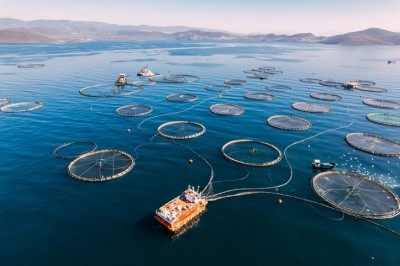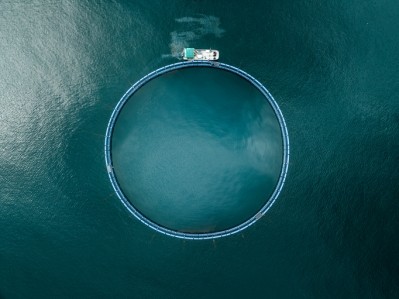Blue Food Innovation Summit, London
Sustainable aquaculture: Mowi, BioMar and policy shapers on solutions

"The bottom line and survival of the business is dependent on getting the sustainability [piece] right," stressed Catarina Martins, CTO, Mowi.
She was joined on the panel by Paddy Campbell, vice president, salmon division, BioMar, Michael Rubino, senior advisor for seafood strategy, NOAA in the US, and Lorella De La Cruz Iglesias, deputy head of unit-blue economy sectors, aquaculture and maritime spatial planning, DG for Maritime Affairs and Fisheries, EU Commission, with Michael Doane of the Nature Conservancy moderating the session.
Ticking ESG boxes
Aquaculture companies are leading the way in relation to meeting ESG criteria, noted Martins.
In 2023, salmon farmers were listed in the top three places of a league table of sustainable protein producers, the Coller FAIRR Protein Producer Index, with another four salmon farmers in the top 10, she remarked. Mowi topped that index, with Lerøy Seafood Group in second place, and Norway and Canada’s Grieg Seafood ranked third.
The league table features 60 of the world’s biggest listed meat, dairy and farmed fish producers and is designed to provide institutional investors with a means to assess how well key suppliers in the food chain are managing environmental, social and governance (ESG) risks. Firms are scored on GHG emissions; deforestation and biodiversity; water use and scarcity; waste and pollution; antibiotics; working conditions; animal welfare; food safety; sustainability governance; and alternative proteins.
“So, this industry is, of course, facing challenges. However, there is a lot of focus on innovation, and there is a lot of good work being done [in the sector]," continued Martins.
Mitigating the environmental impact of feed
Looking at the environmental impact of feed, BioMar’s Paddy Campbell said: “We have to be able to measure what we want in terms of sustainability, then we have to widen our raw material basket to achieve that.”
The aqua feed major has committed to the Science Based Targets initiative (SBTi), requiring it to achieve annual carbon reduction targets.
BioMar approaches its sustainability goals in three main ways, reported Campbell. It focuses on sourcing raw materials that will reduce its carbon footprint. However, its focus extends beyond carbon.
"It's crucial to consider the origins of our raw materials. We aim to use circular and restorative raw materials, including co-products and those from regenerative agricultural practices.
“We also assess our forage fish dependency ratio, which measures the amount of marine raw materials used to produce one kilogram or one ton of farmed fish or shrimp."
Balancing these factors can be challenging, as they sometimes contradict each other, he commented. Nevertheless, all three factors—carbon reduction, sustainable sourcing, and forage fish dependency—are essential and must be measured and tracked, he said.
Engaging with startups and fostering innovation is critical. "We need to collaborate with suppliers to help them develop novel raw materials.”
Regarding human health, prioritizing these initiatives is challenging but necessary, continued Campbell.
There is a significant gap between the supply and demand for long-chain omega-3 fatty acids, such as EPA and DHA, which provide health benefits for both humans and farmed species. Traditionally, these fatty acids have been sourced from fish oil, but now the industry needs alternative solutions, said the BioMar representative.
“We see promising developments in algae fermentation and innovations in crop research, such as genetically modified crop oils, effectively producing fish oil on land. These advancements could significantly reduce the reliance on fish oil in aquaculture feeds, alleviating pressure on marine resources.”
Post-smolt innovation
Martins discussed innovation as it relates to salmon production, with the industry’s heightened focus now on post-smolt strategies. There are growth, welfare and health benefits for salmon that spend more time in freshwater, she outlined.
Shortening the fish’s growth period in the sea may also see fewer problems with salmon lice, added the Mowi CTO.
The idea that salmon are larger and more robust before being released into the sea means they are less susceptible to diseases.
Education and outreach
There is still the need to raise more awareness about the importance of aquaculture, stated De La Cruz Iglesias. “It's not just consumers and citizens who lack understanding, but sometimes even governments are not fully aware of the sector's significance.”
In the EU, aquaculture remains a marginal sector, except in a few countries, she noted.
Social acceptance is another challenge. Concerns about antibiotic use and environmental pollution often dominate discussions about aquaculture. However, there are many misconceptions and a lack of knowledge about how the sector operates and the stringent regulations in place to mitigate impacts, said the EU Commission representative.
“Political will is crucial to explain why aquaculture is important, its role, and its benefits to society and the economy. This is especially true for coastal and remote communities across Europe and globally. For these areas, aquaculture offers significant job opportunities, particularly as traditional fishing stocks decline. It can help keep people in their communities by creating new employment opportunities and providing alternative sources of revenue."
This aspect of supporting local economies and maintaining community stability is not sufficiently highlighted in discussions about aquaculture, she commented.
Outreach and education, including putting a human face on those involved in production, will be critical in ensuring greater consumer buy-in for fish and shrimp farming, says Rubino.
“Bringing these stories to the public through social media and television programs can significantly raise awareness and improve social acceptance. These efforts are essential for enhancing the social license of aquaculture.”
He highlighted 'Hope in the Water' a four-part docuseries about the future of blue foods, scheduled to be broadcast in the US this year, as a way to acheive that end. Aquaculture advocate, Jennifer Bushman, who also spoke at Blue Food Innovation is the co-founder of Fed by Blue and the executive producer of that docuseries.




















